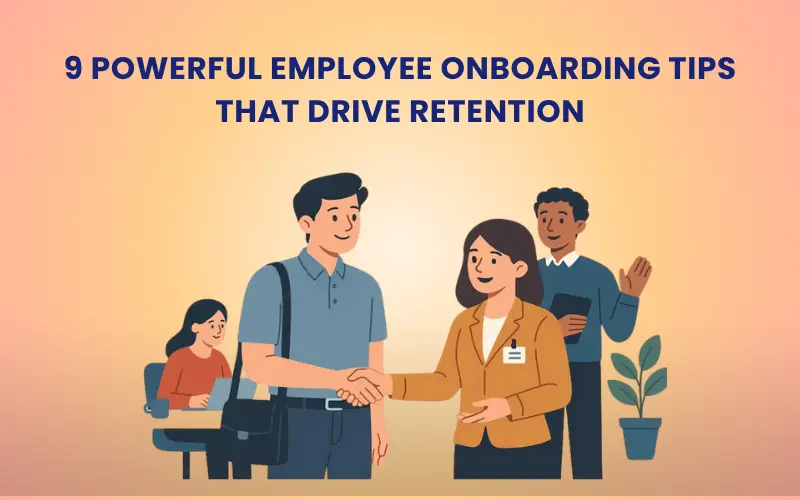The way your business interacts with new employees determines how employee onboarding goes. In the modern company, first impressions count. Effective employee onboarding increases daily productivity and retention right away. Organizations with well-defined plans find 50% more new employee productivity. Many businesses, meanwhile, find it difficult to provide significant events that turn new hires into active team members. From day one, these nine useful techniques will enable you to achieve a flawless transition that increases engagement, speeds up production, and greatly enhances staff retention.
What Makes Onboarding Crucial for Success
Effective onboarding lays the groundwork for the entire employee experience while also producing measurable business results. When done correctly, it lowers the risk of early turnover and can cut time-to-productivity by as much as 60%. Participating in organized onboarding programs increases an employee’s likelihood of staying with the organization for three years or longer by 58%.
The whole onboarding timeline runs from pre-boarding to the first year of work, meeting various demands at each stage. Organizations that treat onboarding as an ongoing process rather than a one-day event see higher engagement scores and performance metrics.
9 Employee Onboarding Tips
#1: Start Before Day One
Begin engaging new hires immediately after offer acceptance. Establish a consistent communication cadence that builds excitement and reduces anxiety. Digitize administrative paperwork so they can complete it before arrival, and provide early access to relevant company resources where appropriate.#2: Create a Welcoming First-Day Experience
Make the first day memorable by emphasizing connection rather than information overload. Ensure the workstation is fully set up before arrival and place a Sugarcoat welcome kit that reflects your culture and values. This personalized gesture creates an immediate sense of belonging and shows that you prepared with the new hire in mind. Introduce them to the team in a relaxed setting instead of a series of back to back meetings, and pair the orientation with one meaningful task so they end the day feeling productive and confident. First-Day Essentials:- Fully prepared workspace with technology
- Sugarcoat welcome kit with branded items and personal note
- Team lunch or coffee break
- Introduction to key collaborators
- First meaningful task
#3: Provide the Right Tools Immediately
Make certain that new hires have instant access to all the tools they need to do their jobs. Put in place all-inclusive employee management software or a dedicated employee onboarding tool that simplifies processes for onboarding and performance evaluation. These solutions give new hires a consolidated way to access team directories, corporate regulations, and training resources while also greatly reducing the administrative load.
The right employee management system creates consistency across departments and gives managers real-time visibility into onboarding progress. It also empowers new hires by providing self-service access to common questions and resources, reducing their dependency on others for basic information.
To really succeed, think about using specialized tools:
- Onboarding Software: To make the onboarding process smooth and effective, especially for IT sectors, platforms such as Onboardix’s AI-Powered Onboarding Tool may automate bespoke workflows, offer AI chatbots for immediate query response, and produce data-driven reports.
- Human Resources Management (HRM) Systems: For small firms seeking an all-in-one platform, robust HRM software, like Tanca-HRM Software, can combine all facets of HR, from managing schedules and payroll to managing documents and staff.
- Integrated Employee Management Solutions: To improve overall operational efficiency, you can find systems that provide features like performance reviews, attendance tracking, and secure data management by looking through the Employee Management Software. This will give you a more comprehensive approach to HR and employee supervision.
- EOR tools: These solutions act as a legal employer in countries where you don’t have a local presence, allowing you to hire and onboard international employees compliantly. By managing contracts, payroll, tax obligations, and statutory benefits, global employer of record services for remote companies eliminate the regulatory burdens of cross-border employment—making them a powerful tool for remote-first businesses scaling globally.
These tools not only automate administrative tasks but also provide valuable insights into employee progress and engagement from day one.
#4: Implement a Buddy/Mentor System
Pair new hires with experienced employees who can provide day-to-day guidance and social connection. Research shows that having a dedicated onboarding buddy makes employees 23% more satisfied with their overall experience. Select buddies who combine organizational knowledge with approachability, and provide clear guidelines about their responsibilities.
#5: Design a Clear 30-60-90 Day Plan
Create structured milestones that provide clarity and measurable progress indicators. The first 30 days should focus on learning and orientation with achievable early wins. By 60 days, employees should handle routine responsibilities with increasing independence. The 90-day mark should show near-full productivity and initiative-taking within role boundaries.
Schedule formal check-ins at each milestone to provide feedback, address concerns, and adjust expectations as needed.
#6: Focus on Culture Integration
Beyond outlining policies, immerse new staff in how your firm actually runs. Share tangible examples that demonstrate the company’s ideals in action, and offer intentional chances for social inclusion outside the immediate team. Give employees early exposure to diverse departments to help them grasp how their role fits into the wider picture.
#7: Deliver Role-Specific Training
Balance general orientation with focused e-learning modules for consistency. Break complex processes into digestible microlearning segments effectively. E-learning allows for diverse learning speeds and styles. According to studies, e-learning increases retention rates by 25-60% when compared to traditional approaches.
Incorporate video demonstrations and interactive quizzes throughout the content. Provide self-paced training materials at any time and from any location. This fits different schedules and learning styles.
Effective Training Approaches:
- Training modules lasting 5-15 minutes each
- Video demonstrations of key processes
- Provide self-paced access to training materials
- Hands-on practice with real scenarios
- Quick reference guides for common tasks
#8: Gather and Implement Feedback
Deploy pulse surveys at key milestones (first week, 30 days, 90 days) to capture insights while experiences are fresh. Conduct exit interviews with any early departures to identify potential onboarding gaps. Most importantly, create a closed-loop system where feedback directly influences program improvements.
#9: Extend Onboarding Beyond 90 Days
Organizations with top retention rates recognize that full integration takes longer than three months. Create meaningful milestones to celebrate progress throughout the first year, and shift conversations from immediate role mastery to longer-term career development around the six-month mark.
Key Takeaways
Effective onboarding represents one of the highest-return investments in talent management. The most successful programs take a phased approach:
- Phase 1 (Pre-start to Week 2): Welcome, logistics, and team connections
- Phase 2 (Weeks 3-8): Role clarity and organizational understanding
- Phase 3 (Months 3-6): Cultural integration and independent contribution
- Phase 4 (Months 7-12): Growth planning and expanded impact
The ROI is compelling – organizations with strong onboarding see 50% greater new-hire productivity and up to 69% higher three-year retention rates. By implementing these strategies, you transform onboarding from an administrative process into a strategic advantage that builds the foundation for lasting employee engagement.




